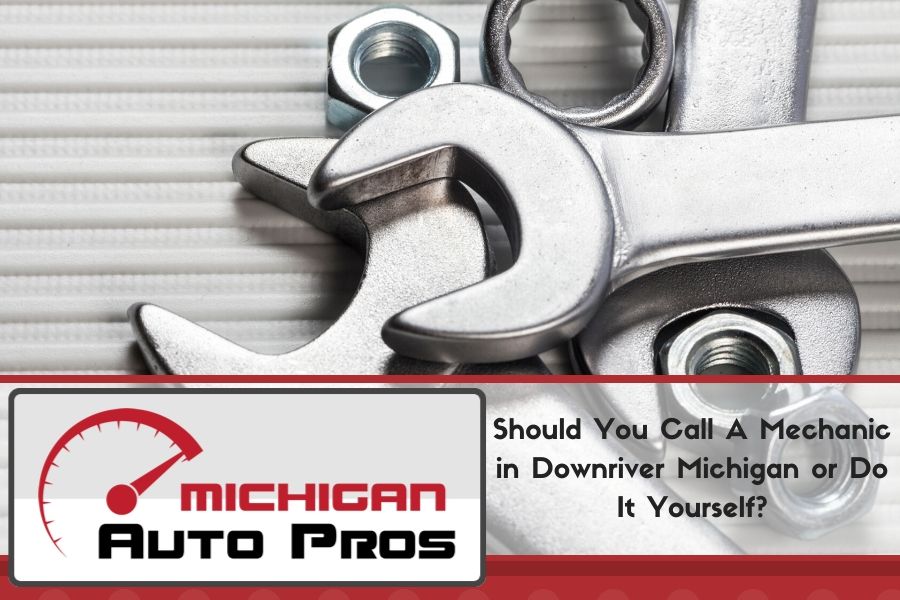With the ever increasing cost of living, many people look to save money by doing small mechanical jobs themselves. In addition to savings, the sense of pride associated with a job well done has many do-it-yourselfers putting down their wallets and picking up a wrench. Armchair auto mechanics are legion, and for good reason – many common points of maintenance can indeed be performed in your driveway over the course of an afternoon. But just because you can doesn’t always mean you should. Let’s take a look at a few common DIY projects to better understand when it’s time to call a professional mechanic in Downriver Michigan.
Should You Call A Mechanic in Downriver Michigan or Do It Yourself?
Often an introduction to automotive maintenance, the oil change can absolutely be performed at home with only a few basic tools. If you’ve done this before, you probably know what to expect. However, if you’ve never done an oil change but are thinking of trying for the first time, please take a few things into consideration.
First, cars are heavy. How do you plan to support the vehicle while getting under it to drain the oil and change the filter? If not properly secured, the consequences could be fatal. Once the oil is drained, do you have an environmentally sound (and legal) way of disposing of it? Simply pouring oil down the drain is not an option. And lastly, do you have all of the necessary parts and tools? Dumping the oil only to find you stripped a drain plug and now have no way to drive to the store is a headache at best. Plan ahead, and work efficiently.

The Brake Job
Any modern braking system consists of yards of hydraulic hose, sensors, and pumps; in addition to the more visible components like calipers and rotors. Generally, when someone plans to do a brake job, they’re talking about changing the pads. Brake pads are pressed against the rotor by the caliper, and are subject to extreme temperatures as they slow the car. As such, brake pads are a consumable item and need to be replaced from time to time.
Although not as easy as an oil change, brake pads are fairly straightforward. They generally require the removal of the wheels in order to access them, which involves proper suspension of the vehicle. Once removed, you’ll be faced with small clips, pins, and sliders; all of which need to be cleaned, lubricated, and properly installed for the system to work. A common error for budding home mechanics is to install the pads backwards. The result is decreased braking, and shortened component lifespan. In some instances, you may need to change or machine down the rotors. If you’re uncertain what this means, it’s best to hire a qualified technician.
The Tire Rotation
In order to promote uniform wear, tires must be periodically rotated. This is generally done in a crisscross pattern at a given interval prescribed by the manufacturer. Rotating your own tires isn’t terribly difficult, but you’ll want to invest in a good floor jack and jack stands, which will easily exceed the cost of taking it into the shop.
While the tires are removed, it’s a great time to inspect for any cracks, bulges, or uneven wear that would require purchasing new tires. Lastly, if you have a full-size spare, it’s best to work that into the rotation as well, to ensure you have a properly functioning tire in an emergency.
The Serpentine Belt
The serpentine belt is responsible for providing power to a number of critical systems and is found on virtually all cars on the road today. A broken belt often translates to a loss of power steering and sometimes a failed water pump, among other disasters. But if you’re thinking of changing it yourself, chances are you already know this.
To have a professional change the belt would generally be somewhere in the vicinity of $200. For the new or weekend mechanic, changing a serpentine belt may prove to be one of the more challenging tasks. The belt often crosses over six or more pulleys, and requires the proper tension to be set before turning the vehicle on. If installed improperly, it could cause significant damage to systems that are spun in a direction opposite of their design. Some vehicles will have a placard under the hood illustrating the belt’s pathway. Proceed with caution.
The Easy Stuff
Certain jobs are so simple they can be done in the parking lot of your local auto parts store. Changing wiper blades is a straightforward task, as the hooks and clips are generally standardized. But be sure to get the proper length for your car. While you’re at it, pop the hood and top off the wiper fluid – a 30-second job, at most.
Many air filters drop right in, and require little more than undoing the clips securing the airbox – a five-minute job. And depending on the make and model, changing the bulb in a tail light is almost as easy as popping the trunk. Tire looking a little soft? Perhaps the easiest job of all is pumping in a little more air. But be sure to check the recommended pressure; generally posted on the inside of the driver-side door well.
Just because a job is considered easy, doesn’t mean problems can’t arise. If you’re unsure, there’s no shame in asking.
Here at Good Care Auto our friendly, ASE-certified technicians are equipped to handle everything from tail lights to timing belts. Everyone has to start somewhere, and we tip our hats to the weekend wrencher. But if you find yourself in over your head, Good Care Auto is standing by to get you back on the road quickly, and affordably. Have a question? Advice is free. Don’t stress, call 734-285-1188 to schedule an appointment with Good Care Auto today!
